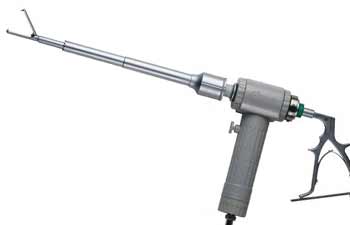Johnson and Johnson Pulls Hysterectomy Device
Written by Jeff Meyer on 15 May 2015

Laparoscopic power morcellators have had a long history in the medical industry. However, over the last year or so, they have fallen out of favor as researchers have found they can actually put women at risk for cancer. While the FDA and a number of insurance companies in the US have come out against this device, the biggest impact may come from Johnson & Johnson. The multinational corporation and number one producer of these devices has decided to pull all of them currently on the market.
What Morcellators Do
Morcellators have been used in the United States since 1993. However, since 2014, the FDA has been rallying against their use. The reason is simple: the devices can help the spread of cancer in women.
The device itself has a handle on one end, where the surgeon grabs and operates it. Then there’s a long, slender tube with spinning blades at the end. When performing a hysterectomy, myomectomy or similar procedure, the surgeon will make a slim incision, and then stick through device through. Once it has reached the section of interest, the surgeon will turn on the blades, which will then get busy clearing its surroundings of any fiber.
If that’s all it does, the morcellator will be considered a success. A tiny vacuum will get inserted to suck out the debris and this part of the procedure will be over. Furthermore, the patient will have a very slender opening (usually about two centimeters) as opposed to the several inches or more that would be necessary for a surgeon to handle the clearing manually.
The Risk of Using a Morcellator
Unfortunately, if there are cancerous cells present in the area, a morcellator becomes a tool that will inadvertently spread it. What happens is that the spinning blade actually cuts into the cancerous growth and sends pieces throughout the body. Wherever they land, these cancerous cells can produce a full-blown tumor.
Johnson & Johnson Calls It Quits
Like we said at the beginning, both the FDA and many insurance companies have supported efforts to reduce the use of morcellators. This has largely involved adding educational labels to the products and speaking directly with surgeons and patients.
However, at this time, there’s no way any of these parties can actually pull product. Only the manufacturers can currently do this which is exactly what Johnson & Johnson did last year.
This was no small gesture either. As the largest manufacturer of morcellators in the world, Johnson & Johnson’s move will definitely have a noticeable impact on the market.
The company even took things a step further by releasing a letter to the public, asking customers to return their devices. Johnson & Johnson also had a new morcellator they were planning on releasing this past year. That device’s development has since been permanently suspended.
It’s worth pointing out that, originally, Johnson & Johnson was reticent on the issue of morcellators. When the FDA first began speaking out, the company only said that they were waiting to hear more from the medical community.
Only after the FDA held hearings on the matter did Johnson & Johnson finally admit there was obviously a problem with devices like the kind they had become the number one manufacturer for.
Amongst other things, that’s an important development as it could send a ripple effect throughout the industry. Many surgeons continue to use this device, apparently convinced the risks are overblown. Now that Johnson & Johnson has come around, many other members of the medical community may do the same. Otherwise, the FDA will is sure to continue their efforts to better educate the public.
Source:
http://www.wsj.com/articles/johnson-johnson-to-call-for-voluntary-return-of-morcellators-1406754350

Leave a Reply